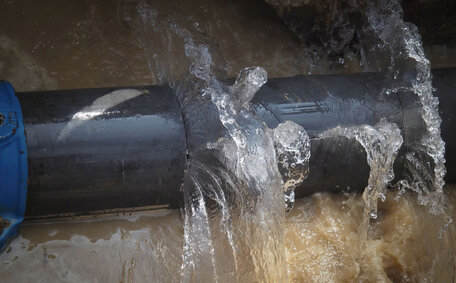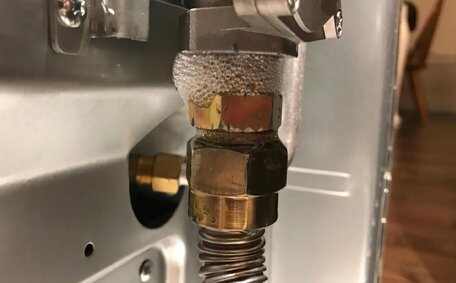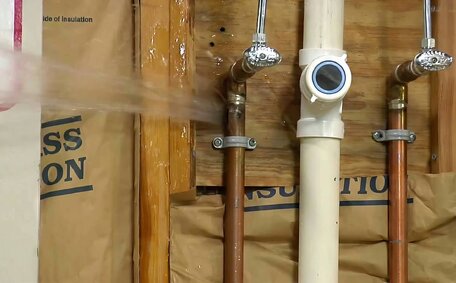Recognizing There’s a Problem With Your Hot Water System
Recognising There’s a Problem With Your Hot Water System
There are a few key signs that may indicate an issue with your hot water system. If you notice any of the following, it’s worth investigating further:
- The water remains cold or doesn’t reach a sufficient temperature
- Decreased water flow or low pressure, which may be caused by leaks
- Strange noises coming from the hot water system, like banging or rumbling
- Visible leaks around the hot water unit or pipes
One of the most critical components is the drain valve. This valve is essential for routine maintenance, including sediment removal. If it becomes stuck or blocked, it can cause problems.
Addressing these signs early can avert severe damage and expensive repairs. If you notice anything concerning about your hot water supply, contact a licenced plumber to inspect your electric water heater.
Performing Initial Checks on Your Non-Functional Hot Water System
When troubleshooting a non-functional hot water system, there are a few initial checks that can help determine the cause of the problem:
- Verify power supply - Check your electrical switchboard or circuit breakers to ensure power is getting to your hot water system. For gas systems, ensure the gas line is on.
- Reset the system - Many systems have reset buttons, so push that first to see if it restores hot water function.
- Check pilot light (gas systems) - If you have a gas system, check that the pilot light didn’t go out. Re-light it if needed.
- Adjust thermostat - Make sure your hot water system’s thermostat didn’t get turned down too low.
- Check for water leaking - Visually inspect pipes, connections, valves and the water heater for any leaks that could indicate a fault.
These initial troubleshooting steps should only take a few minutes but can help narrow down any glaring issues. If simple fixes like these don’t restore your gas electric water supply, then it’s time to call a professional plumber for a more thorough diagnosis and repair.
Attempting to fix complex issues yourself without proper training can lead to gas leaks, electric shocks, floods or further damage. For safety reasons, it’s prudent to engage a licenced professional for advanced troubleshooting.
Checking the Power Supply
To check that your hot water system is receiving power properly, start by locating the electrical switchboard that controls the circuit for the water heater.
Make sure the circuit breaker controlling the hot water system is switched to the "On" position and hasn’t tripped. You can try flipping the breaker off and back on again to reset it.
Also check that the power cord or direct wiring leading to the water heating unit is still intact and connected securely. Trace the cord to ensure there are no visible breaks or faults. If you find any damage, do not try to repair it yourself due to the electrical shock risk.
For gas water heaters, make sure to turn off gas to the unit before inspecting and ensure that the gas line is supplying fuel when turned back on. Listen and smell near the pilot light for signs of gas flow. If the pilot light won’t stay lit, there may be a problem with the thermocouple or gas control valve.
Verify that any issues with power supply or gas flow are corrected before proceeding further. No hot water is one possible symptom of power or fuel delivery problems, but other more complex faults could still exist even if those basics check out.
If you’ve confirmed the water heater has power but hot water is still not running properly, contact a professional plumber to get your hot water tank functioning again. Attempting DIY repairs on gas or electric systems when unqualified puts your safety at risk.
Resetting Your Hot Water System
Resetting your electric gas water system can often resolve temporary glitches and get your hot water flowing again. Both electric and gas systems usually have a reset button located on the control panel or thermostat.
Before resetting the system, make sure the power supply or gas is still connected and turned on as described in the previous section. Resetting the system without an energy source won’t resolve the issue.
- Locate the reset button, which may be red or labelled clearly.
- Press and hold the reset button for 5-10 seconds.
- Some systems may power cycle, shutting off then restarting.
- Go and check hot water quality at a tap to see if hot water is restored.
A reset can fix minor software glitches that may be hindering system operation. In some cases it can dislodge small blockages or relight pilot lights. It’s one of the easiest troubleshooting steps to try before calling a professional.
If resetting your system doesn’t bring back hot water, the issue is likely hardware-related. At that point it’s best to contact a licenced plumber to properly inspect and service the system.
Inspecting the Pilot Light on a Gas System
If you have a gas hot water system, verifying the pilot light is one of the first troubleshooting steps to try. The pilot light is a small flame inside the main burner chamber that ignites the gas when hot water is needed.
To inspect it:
- Locate the view window where you can see the pilot light inside the burner area.
- Check if the pilot light lit and burning properly. You should see a small steady flame that may be blue or yellow.
- If it’s not lit, the thermocouple safety device may have shut off gas flow. Press the reset button and try igniting it again.
- If it won’t stay lit for more than 5 minutes, shut off gas supply and call a plumber, as there could be an issue with gas pressure, thermocouple, or control valve.
A properly burning pilot light is essential for reigniting the burner when water is needed for heating. If gas is leaking and you smell it, immediately shut off gas supply and ventilate the area before calling emergency gas fitters.
Adjusting Your Hot Water System’s Thermostat
The thermostat controls the temperature of the water heating in your system. It’s important to set it appropriately—not too hot to prevent scalding but hot enough for comfort and efficiency.
A typical water heater thermostat temperature range is 120°F to 140°F (49°C to 60°C), ensuring that your water temperature is always ideal for comfort and safety. Higher settings risk scalding and are possibly too high, but do allow more hot water capacity. Lower temperatures reduce efficiency and may breed bacteria.
To adjust your hot water system’s thermostat:
- Locate the thermostat on the control panel of your hot water unit.
- Turn hot water dial or press buttons to raise or lower the temperature setting.
- After adjusting, run a hot tap and use a thermometer to verify the output temperature.
- Repeat small adjustments until the temperature is suitable.
Get professional help if unable to access controls or if temperature fluctuations persist despite adjustments. Thermostats control critical safety functions.
Maintaining Your System Through Regular Flushing
Flushing your hot water tank regularly is crucial to remove sediment buildup and maintain efficiency. Over time, mineral deposits and corrosion particles can accumulate on the heating element at the bottom of your tank, reducing its capacity and performance.
To flush the system:
- Turn off power to the hot water unit and shut off incoming water supply.
- Attach a garden hose to the drain valve located near the bottom of the tank.
- Open the drain valve and let water flow out until it runs clear with no visible sediment.
- Close drain valve, refill system with water, restore power & water supply.
Flushing once a year removes built-up layers of silt and limescale, allowing your hot water system to reheat water faster and more efficiently. It also extends the operating life by preventing corrosion and deterioration internally.
If draining takes longer than 15 minutes or water remains discoloured, your system may require descaling by a professional. Preventative maintenance saves money over replacing neglected water heaters.
Identifying and Addressing Water Leaks
Detecting leaks early is key to prevent water damage or mould risks. There are a few telltale signs of leaks to watch for:
- Visible water puddles or drips around the hot water unit, pipes, or valves
- Unusually wet areas or moisture on walls or floors near the system
- An increase in your water bill may indicate a hidden leak
The The drain valve is a frequent leak source and should be inspected for tightness or corrosion. Try tightening the valve or replace it if corrosion is visible. Also inspect tank pipes and fittings for wetness or limescale buildup as signs of small leaks.
Catching a tank leaking quickly can prevent the need to replace an entire system. But If the water tank itself is leaking, it likely means failures within the lining, indicating the end of its lifespan. In that case, a full system replacement is required.
Avoid DIY repairs on gas water heaters to eliminate the risk of igniting a gas leak. Leave all gas or electric hot water repairs to qualified technicians for your safety.
Knowing When to Call a Professional Plumber
Some hot water system issues can be tackled DIY, but others necessitate a licenced plumber to ensure safety and accurate diagnosis:
- You smell gas leaks or the pilot light goes out repeatedly
- The system is over 10 years old and likely near the end of its lifespan
- There are complex issues like pressure fluctuations or electronic control failures
- Attempts to relight the pilot or reset the system fail to restore hot water service
- Significant and persistent leaks are visible around the water heater or pipes
- Any work involving gas lines, fuel hookups, or electricity should only be handled by qualified technicians to prevent risks
Randwick Plumbing possesses the expertise needed to diagnose and resolve issues with your hot water system. We handle jobs of all sizes and types, from simple thermostat adjustments to full re-plumbing of domestic and commercial sites.
Don’t take chances; learn how to fix simple hot water issues on your own or call us for professional help. Call our office on 1300 349 338 for professional assistance tailored to your needs.
Implementing Preventative Measures
Implementing some simple preventative measures can help keep your hot water working smoothly and avoid many common issues with hot water systems:
- Annually flush the water heater to clear sediment accumulation
- Visually inspect the relief valve, drain valve, pipes, and tank for leaks every 3 months
- Schedule a licenced plumber to inspect the system every three to five years
- Consider replacing systems that are over a decade old
- Keep the thermostat appropriately adjusted
- Don’t overlook warning signs such as unusual noises or evident leaks
Proactive measures are more effective than reactive ones for plumbing maintenance. Staying on top of maintenance and repairs can extend the lifespan of your system, improve efficiency, and prevent expensive emergency callouts.
For expert maintenance or replacement of your hot water heater, reach out to Randwick Plumbing. Leveraging over 25 years of experience, we’ll expertly assess your setup and offer guidance. To book an appointment, call 1300 349 338 or email [email protected].






